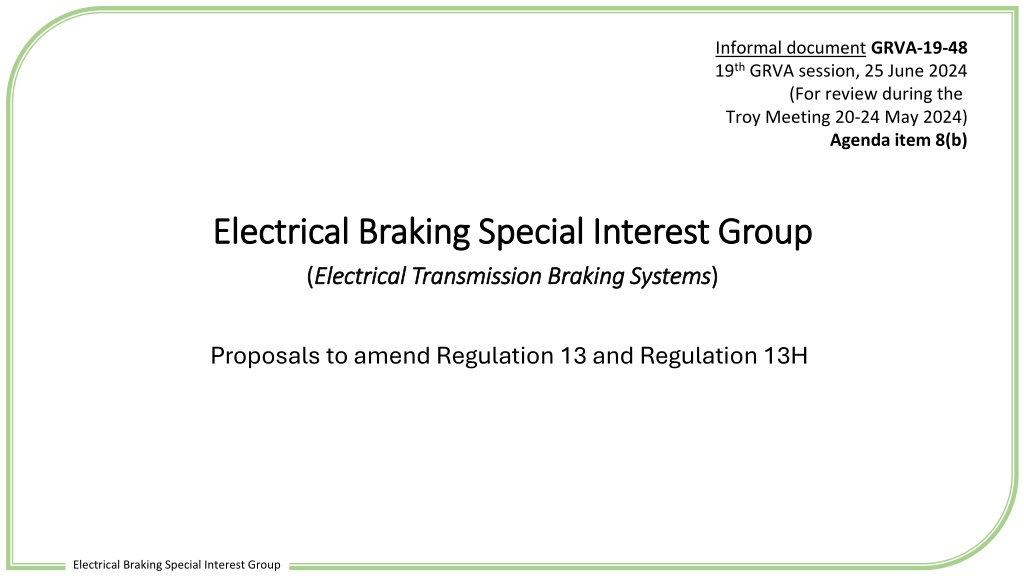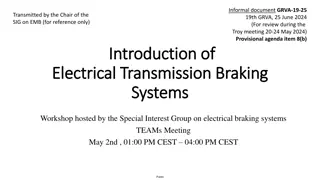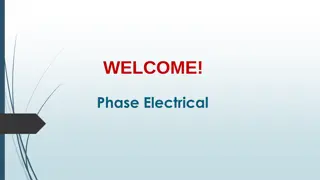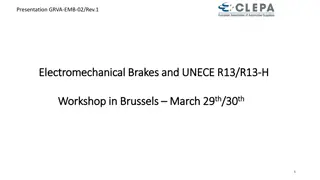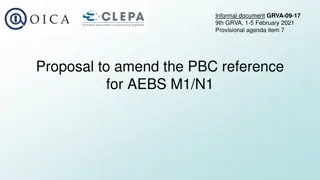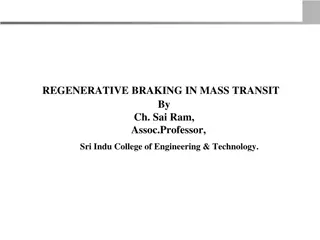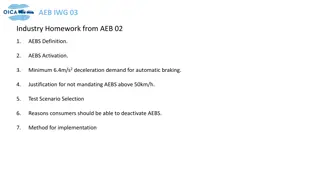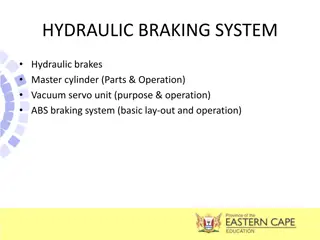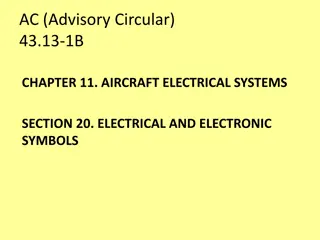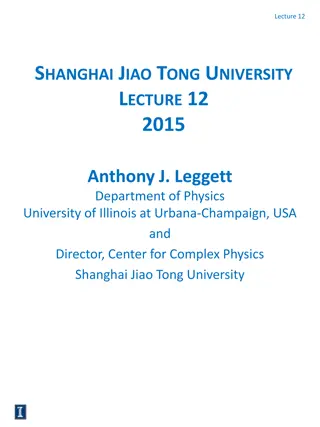Proposal to Amend Regulations for Electrical Transmission Braking Systems
The document covers proposals to amend Regulation 13 and Regulation 13H for electrical braking systems, focusing on electrical transmission braking systems. It discusses changes in requirements, provisions, and special additional requirements, along with workshops and meetings by the Electrical Braking Special Interest Group (EBSIG).
Download Presentation

Please find below an Image/Link to download the presentation.
The content on the website is provided AS IS for your information and personal use only. It may not be sold, licensed, or shared on other websites without obtaining consent from the author. Download presentation by click this link. If you encounter any issues during the download, it is possible that the publisher has removed the file from their server.
E N D
Presentation Transcript
Informal document GRVA-19-48 19th GRVA session, 25 June 2024 (For review during the Troy Meeting 20-24 May 2024) Agenda item 8(b) Electrical Braking Special Interest Group Electrical Braking Special Interest Group ( (Electrical Transmission Braking Systems Electrical Transmission Braking Systems) ) Proposals to amend Regulation 13 and Regulation 13H Electrical Braking Special Interest Group
Documents for Consideration Documents for Consideration Regulation 13 Regulation 13H GRVA/2024/25 - Proposal GRVA/2024/26 - Proposal GRVA-19-23: Amendments to the above GRVA-19-24: Amendments to the above GRVA-19-25 Workshop Presentation: Introduction of ETBS Electrical Braking Special Interest Group
Meetings EBSIG Meetings EBSIG The meetings followed the Terms of Reference agreed at GRVA 16. EBSIG s Meetings EBSIG s - Virtual Meetings EBSIG-01: 12-13 July 23, Brussels(CLEPA) EBSIG Virtual 01 : 16 February 24 (EMS) EBSIG-02: 24-26 August 23, Paris (OICA) EBSIG Virtual 02 : 23 February 24 (Auxiliary Equipment) EBSIG-03: 10-12 October 23, Brussels (CLEPA) EBSIG Virtual 03 : 01 March 24 (Annex7, indicator) EBSIG-04: 7-9 November 23, Paris (OICA) EBSIG Virtual 04 : 08 March 24 (Outstanding issues) EBSIG-05: 12-14 December 23, Paris (OICA) EBSIG Virtual 05 : 15 March 24 (EMS) EBSIG-06: 9-11 January 24, Berlin (VDA) EBSIG Virtual 06 : 21 March 24 (Remaining items) EBSIG-07: 6-8 February 24, Berlin (VDA) All documents from the EBSIG can be found on the UN Wiki: Electro-Mechanical Braking (EMB) - Transport - Vehicle Regulations - UNECE Wiki Electrical Braking Special Interest Group
Principal Changes Principal Changes Regulation 13 Regulation 13H Special additional requirements for electrical transmission braking systems. Regulation: New Section 5.2.1.35. Regulation: New Section 5.2.24. Provisions relating to energy sources and energy storage devices (energy accumulators) Annex 7: Annex 4: New Part D New Part B Special requirements to be applied to the safety aspects of complex electronic vehicle control systems Annex 18 Annex 8 Revised Requirements Revised Requirements Electrical Braking Special Interest Group
General Changes General Changes The introduction of new definitions to aid understanding and interpretations of the requirements. Adjustment of the existing general requirements to ensure that they remain applicable to this new technology, e.g.: Two independent braking circuits with their own energy reserve. Sufficient capacity of the energy reserves to ensure braking capability. At least two circuits capable of providing secondary brake performance. Appropriate brake performance from the specific brake controls. Appropriate warning signals when braking performance cannot be ensured. Brake reference values (brake demand values) for PTI. Electrical Braking Special Interest Group
Special additional requirements for electrical transmission braking systems. Special additional requirements for electrical transmission braking systems. New Terminology Electrical Storage Device Energy Reservoir Performance Capacity State Pressure o The existing provisions for electrically controlled braking systems were reviewed, adapted and supplemented. o Provision of technical freedom for system architecture: Systems with/without an energy source. Systems with/without an energy supply. Systems using a traction battery as a supply and/or storage. o Special attention given to the security of the electrical storage devices. Recognition of the shared use of an electrical storage device for systems/equipment other than braking Protection of the braking system. o o Automatic braking in the event of a low energy value (low state). Electrical Braking Special Interest Group
Energy Management System. Energy Management System. Example: Lead acid battery state detection| basic principle Voltage Estimator of battery states & parameters Examples of Predictors A Current Indicator 5.2.1.13.2. (UN R13) 5.2.14.4. (UN R13-H) V Model of the battery Temperatur e - + State of the electrical storage device Adaption of parameters T Determine effect of ageing Warning light 5.2.1.35.6 (UN R13) 5.2.24.6 (UN R13- H) State variables and model parameters as an input for the Predictors Signals to be measured and given as an input for the model of the battery ( voltage ,current, temperature) Warnings and Indicators are continuously triggered Load profiles (number of brake applications) Influences like low temperature, high temperature, the exchange of electrical storage device, ageing; long-time parking to be considered and covered. Electrical Braking Special Interest Group
Requirements for the Energy Management System. Requirements for the Energy Management System. The energy management system must continuously assess the electrical storage devices and activate the required warning signals. If the assessment is not complete at the beginning of a start/run cycle, a warning signal must be activated and remain active until the safe status of the system has been confirmed. The manufacture must provide the Technical Service with a detailed overview of the energy management system, explaining its: architecture, and functionality. information about the energy management system strategy. a list of all the input variables. a sensitivity analysis showing how each of the variables affects the capability of the energy management system. By suitable testing, and in conjunction with the requirements of Annex 18 (Annex 8 in R13H) the Technical Service must: verify that the energy management system accurately identifies the condition at which the warning signals are required. verify the accuracy of the energy management system is ensured under all operating conditions. Electrical Braking Special Interest Group
Requirements for the Electrical supply and the Electrical Storage Devices. Requirements for the Electrical supply and the Electrical Storage Devices. New requirements in Annex 7 (R.13) and Annex 4 (R.13H) Part D. Section 1. Tests to ensure that the electrical storage device has sufficient performance (capacity) to provide braking after the low energy warning is given. Test condition - when the state of the electrical storage device is equivalent to the end of useful life condition of the device. Section 2. Where the electrical storage devices rely on an on-vehicle supply, tests to ensure that the supply can maintain the state of the device under high usage conditions. Electrical Braking Special Interest Group
Special requirements to be applied to the safety aspects of electronic control systems Special requirements to be applied to the safety aspects of electronic control systems For R.13 these changes are contained in document GRVA/2023/10. GRVA/2024/25 includes adjustments to the implementation dates. For R.13H they are integrated into the ETBS proposal GRVA-2024-26. The changes are based upon the latest provisions for Regulation 79. They: Extend the system assessment to all electric control systems not just those that are identified as complex . They clarify the amount of system detail required from the manufacturer. They clarify the tasks that the Technical Service is required to undertake. The changes have the added intention of providing greater alignment across the appropriate regulations with the objective of avoiding regulation specific documentation. Electrical Braking Special Interest Group
Amendments to GRVA/2024/25 (Regulation 13): GRVA Amendments to GRVA/2024/25 (Regulation 13): GRVA- -19 19- -23 23 The 11 amendments can be split into 3 groups: 1 Editorial/Clarification (7) Paragraphs: 2.44., 2.5.3., 5.2.1.13.1., 5.2.1.13.1.2., 5.2.1.35., 5.2.1.35.17.2., and Annex 13, Appendix 2, Para. 1.1.3. 2 Performance Related (3) Paragraphs: 5.2.1.35.1., 5.2.1.35.11., and 5.2.1.35.13. 3 PTI (1) Paragraph 5.1.4.6.2.1. Electrical Braking Special Interest Group
GRVA/2024/25 GRVA/2024/25 - - Significant Amendments (4) Significant Amendments (4) Performance 5.2.1.35.1. Ensures that secondary braking performance is available before the parking brake can be released. 5.2.1.35.11. Ensures that a red warning signal is activated if at any time there are not at least two independent circuits each able to provide secondary braking performance. 5.2.1.35.13. Ensures that, in the event of a failure in a braking circuit, secondary braking performance can still be achieved. As is the case today, this may be by use of the service brake control or by a separate control. PTI 5.2.1.35.13. The existing requirements for brake reference values were adapted to ensure that an ETBS braking system could provide a brake input value that was equivalent to measuring the pressure in an actuator of a compressed-air braking system. The amendment goes further than the current requirements for compressed-air braking systems. It requires that the manufacturer displays the brake input values (brake demand values) so that they can be read from the driving position. Electrical Braking Special Interest Group
Amendments to GRVA/2024/26 (Regulation 13H): GRVA Amendments to GRVA/2024/26 (Regulation 13H): GRVA- -19 19- -24 24 The 8 amendments can be split into 3 groups: 1 Editorial/Clarification (6) Paragraphs: 2.26., 2.34., 5.2.14.1., 5.2.14.1.2., Renumbering paragraphs (5.2.24.16., 5.2.1.24.17., and 5.2.1.24.17.1.) and Annex 6, Appendix 2, Para. 1.1.3. 2 Performance Related (1) Paragraphs: 5.2.4.4.1. 3 PTI (1) Paragraph 5.1.4.4.1.1. Electrical Braking Special Interest Group
GRVA/2024/26 GRVA/2024/26 - - Significant Amendments (2) Significant Amendments (2) Performance 5.2.4.4.1. This paragraph mirrors paragraph 5.2.1.5.4.1. for Regulation 13. However, passenger cars must ensure secondary braking using the service brake control and therefore the option provided for a separate control is not valid in Regulation 13H. PTI 5.1.4.4.1.1. As for Regulation 13. The existing requirements for brake reference values were adapted to ensure that an ETBS braking system could provide a brake input value that was equivalent to measuring the pressure in an actuator of a compressed-air braking system. The amendment goes further than the current requirements for compressed-air braking systems. It requires that the manufacturer displays the brake input values (brake demand values) so that they can be read from the driving position. Electrical Braking Special Interest Group
THANK YOU Electrical Braking Special Interest Group
